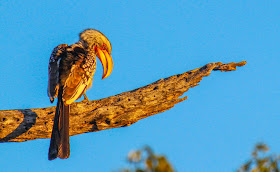One of my favorite birds is the hornbill and in Hwange NP in Zimbabwe we were finding them continuously one day and our guide eventually stopped stopping when we saw them. On my own, I would have continued stopping: I loved them.
For a reason I don't understand, I couldn't get my 500mm lense to focus on them and my pictures are not as good as I would like.
 |
| When I saw this bird I started singing the kookaburra song to myself. I was doing it all day and into other days. It just seems like a bird that should laugh all day. |
This is the southern yellow-billed hornbill, found in a band across southern Africa which includes almost all of Botswana, Namibia and Zimbabwe, northeastern South Africa, southwestern Angola and eastern slivers of Mozambique.
Whereas the casque (an enlargement of the beak) on the African grey hornbill sits like a large lump on top and is very obvious, the casque on the yellow-billed hornbill covers almost the entire length of the beak (less so in females) and gives the impression that it does not have one. Males have larger bills than females.
 |
| I believe this is a male. |
 |
| And this is a female. |
They have a white belly, a chest lightly striated with black, grey neck and black back plumage with white spots and stripes. The eyes are usually yellow and the skin around the eyes and on the malar stripe (a marking from the base of the bill to the side of the neck) is pink. The eastern yellow-billed hornbill has black around the eyes, one of the major differences.




The RED-billed hornbill, which looks just like this except for the color of the bill, is what Zazu in The Lion King is. I kept singing "The Circle of Life" in my head when I saw them.
ReplyDelete